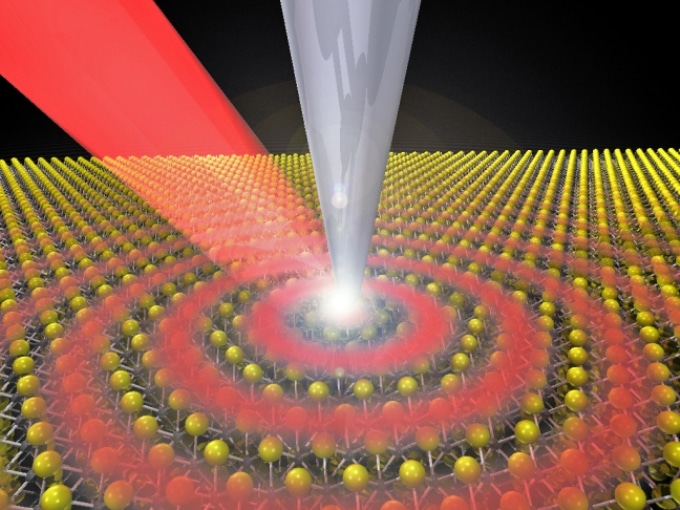Jun 8 2017
A Research group, headed by Zhe Fei from Iowa State University, has captured the first images of half-light, half-matter quasiparticles known as exciton-polaritons. This latest discovery could lead to the development of faster nanophotonic circuits than the present generation of electrical circuits. The study has been reported in the scientific journal, Nature Photonics.
 This image shows how Researchers launched and studied half-light, half-matter quasiparticles called exciton-polaritons. A laser from the top left shines on the sharp tip of a nano-imaging system aimed at a flat semiconductor. The red circles inside the semiconductor are the waves associated with the quasiparticles. Larger image (Image courtesy of Zhe Fei).
This image shows how Researchers launched and studied half-light, half-matter quasiparticles called exciton-polaritons. A laser from the top left shines on the sharp tip of a nano-imaging system aimed at a flat semiconductor. The red circles inside the semiconductor are the waves associated with the quasiparticles. Larger image (Image courtesy of Zhe Fei).
Zhe Fei pointed to a nano-image, dark and bright vertical lines running across his PC screen. He informed that this image demonstrates the waves related to a half-light, half-matter quasiparticle that moves within a semiconductor.
These are waves just like water waves. It’s like dropping a rock on the surface of water and seeing waves. But these waves are exciton-polaritons.
Zhe Fei, Assistant Professor of Physics and Astronomy, Iowa State University and an associate of the U.S. Department of Energy’s Ames Laboratory
Exciton-polaritons are a mixture of matter and light. Similar to all quasiparticles, exciton-polaritons are produced within a solid and possess physical properties such as momentum and energy. In this research, a laser was shined on the sharp tip of a nano-imaging system to launch these quasiparticles. This nano-imaging system was directed at a thin flake of molybdenum diselenide (MoSe2) — a layered semiconductor that supports excitons. When a semiconductor absorbs light, excitons are formed and when these excitons combine strongly with photons they produce exciton-polaritons.
This is a milestone study where Researchers have captured real-space images of exciton-polaritons for the first time. Earlier, spectroscopic studies were used in the Research projects to record exciton-polaritons as resonance dips or peaks in optical spectra, said Fei. Until recently, the majority of studies were only able view the quasiparticles at very cold temperatures, as low as -450 °F.
However, using the scanning near-field optical microscope in his campus laboratory, Fei along with his Research team worked at room temperature to capture the nano-optical images of quasiparticles.
We are the first to show a picture of these quasiparticles and how they propagate, interfere and emit.
Zhe Fei, Assistant Professor of Physics and Astronomy, Iowa State University and an associate of the U.S. Department of Energy’s Ames Laboratory
For instance, the team calculated a propagation length of over 12 microns, which are 12 millionths of a meter, for the creation of exciton-polaritons at room temperature. Therefore, the development of exciton-polaritons at room temperature and their propagation properties are important for devising future applications for the quasiparticles, Fei said. One day, exciton-polaritons may also be used for building nanophotonic circuits to substitute electronic circuits for information transfer or nanoscale energy.
According to Fei, the large-bandwidth nanophotonic circuits could be up to 1 million times faster than today’s electrical circuits.
Fengrui Hu, an Iowa State Postdoctoral Research Associate in Physics and Astronomy, is the paper’s first Author. Additional Co-Authors are Yilong Luan, an Iowa State Doctoral Student in Physics and Astronomy; David Mandrus and Jiaqiang Yan of the University of Tennessee and Oak Ridge National Laboratory; Marie Scott, a recently graduated Undergraduate at the University of Washington and Xiaodong Xu of the University of Washington.
The study was supported by funds from the Ames Laboratory and Iowa State to launch Fei’s research program. The nano-optical imaging for the project was partly supported by the W.M. Keck Foundation of Los Angeles.
The Research team also learned that when the thickness of the MoSe2 semiconductor is changed, the properties of the exciton-polaritons can be manipulated.
Since his graduate school days at the University of California San Diego, Fei has been studying quasiparticles in 2D materials, including grapheme. According to him, his earlier work has paved the way for exciton-polaritons research.
“We need to explore further the physics of exciton-polaritons and how these quasiparticles can be manipulated,” he said.
According to Fei, this could lead to the development of novel devices such as polariton transistors, and one day, may lead to new breakthroughs in quantum and photonic technologies.